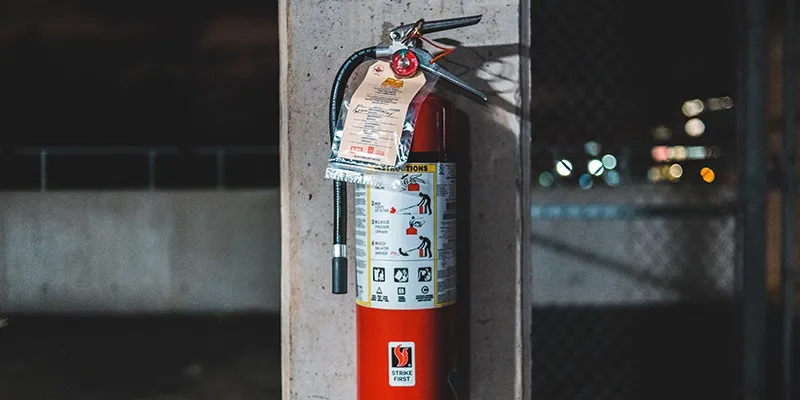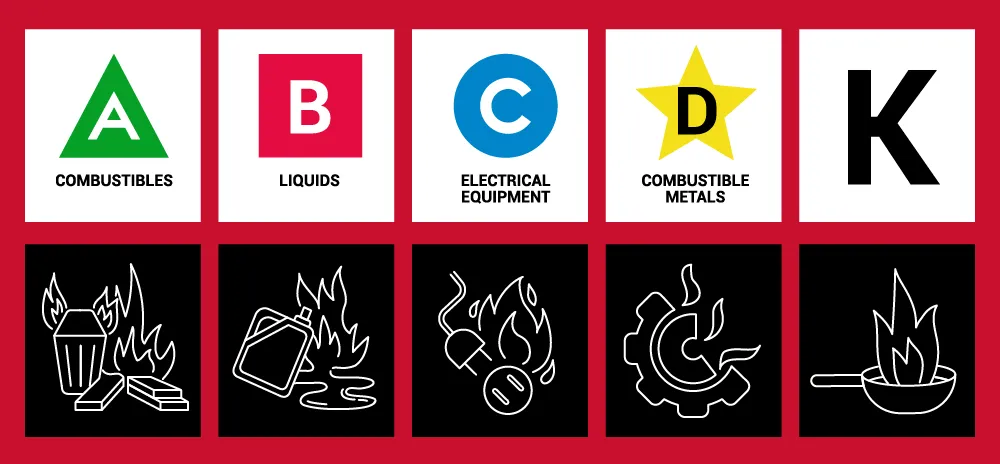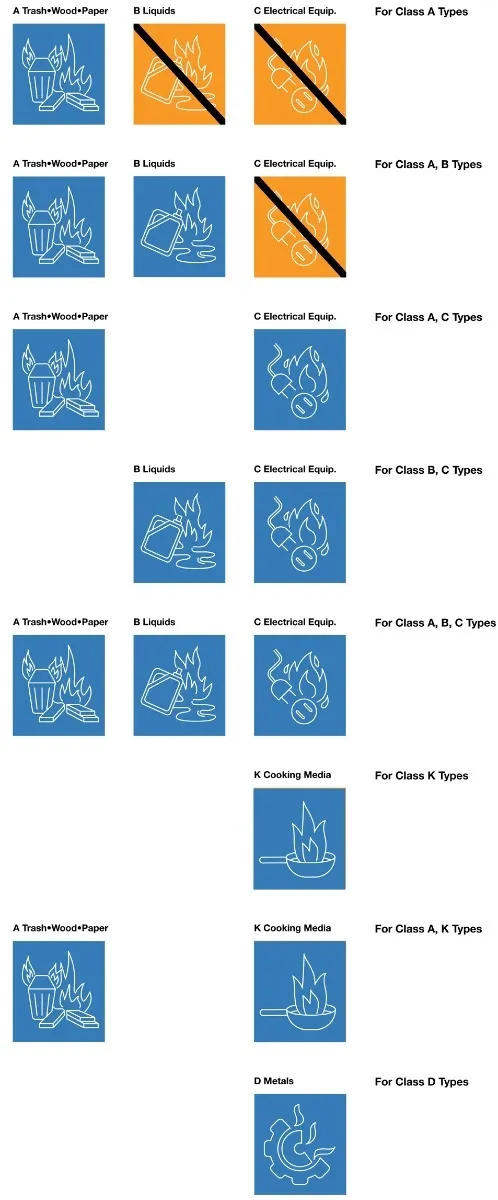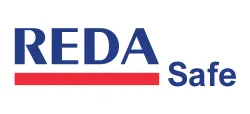Fire Extinguisher Types: How to Choose The Right Fire Extinguisher

Introduction
When it comes to ensuring safety in any environment, be it at home or in the workplace, understanding and choosing the right type of fire extinguisher for the relevant class of fire could literally be the difference between life and death. This crucial decision is more than just a regulatory requirement; it's a fundamental component of any comprehensive fire response plan. In this blog post, we'll guide you through the various types of fire extinguishers available, help you identify which is most appropriate for different classes of fires, and provide you with the knowledge to make an informed decision that could save lives and property. Join us as we dive into the critical nuances of fire safety and preparedness, ensuring that when the heat is on, you're fully equipped to handle the blaze.
The Main Types of Fire Extinguishers
- Water, water mist or water spray
- Foam
- Dry Powder – standard or specialist
- Carbon Dioxide (CO2)
- Wet Chemical
Fire extinguishers are available in different types, with each one having specific fire classes that they are suitable for use on. When using an extinguisher or selecting an extinguisher to install, it’s important to know the characteristics of different fire extinguishers. This blog will address the different types of fire extinguishers by breaking them down by their extinguishing agent, which is the material inside the extinguisher that gets applied to the fire.
Water
Water is the primary liquid used in these extinguishers, although sometimes other additives are also included. A drawback for pure water fire extinguishers is that it is not suitable for use in freezing conditions since the water inside will freeze and render the extinguisher unusable. Certain types of water fire extinguishers contain antifreeze which will allow the extinguisher to be used in freezing conditions. Water type fire extinguishers can also sometimes contain wetting agents which are designed to help increase its effectiveness against fire. These extinguishers are intended primarily for use on Class A fires.
Water mist extinguishers are a type of water fire extinguisher that uses distilled water and discharges it as a fine spray instead of a solid stream. Water mist extinguishers are used where contaminants in unregulated water sources can cause excessive damage to personnel or equipment. Typical applications include operating rooms, museums, and book collections.
Film-Forming Foam Type
AFFF (aqueous film-forming foam) and FFFP (film-forming fluoroprotein) fire extinguishers are rated for use on both Class A and Class B fires. As the name implies, they discharge a foam material rather than a liquid or powder. They are not suitable for use in freezing temperatures. An advantage of this type of extinguisher when used on Class B flammable liquid fires of appreciable depth is the ability of the agent to float on and secure the liquid surface, which helps to prevent reignition.
Carbon Dioxide type
The principal advantage of Carbon Dioxide (CO2) fire extinguishers is that the agent does not leave a residue after use. This can be a significant factor where protection is needed for delicate and costly electronic equipment. Other typical applications are food preparation areas, laboratories, and printing or duplicating areas. Carbon dioxide extinguishers are listed for use on Class B and Class C fires. Because the agent is discharged in the form of a gas/snow cloud, it has a relatively short range of 3 ft to 8 ft (1 m to 2.4 m). This type of fire extinguisher is not recommended for outdoor use where windy conditions prevail or for indoor use in locations that are subject to strong air currents, because the agent can rapidly dissipate and prevent extinguishment. The concentration needed for fire extinguishment reduces the amount of oxygen in the vicinity of the fire and should be used with caution when discharged in confined spaces.
Halogenated Agent Types
Halon
The bromochlorodifluoromethane (Halon 1211) fire extinguisher has an agent that is similar to carbon dioxide in that it is suitable for cold weather installation and leaves no residue. It is important to note that the production of Halon has been phased out because of the environmental damage it causes to the earth’s ozone. Some larger models of Halon 1211 fire extinguishers are listed for use on Class A as well as Class B and Class C fires. Compared to carbon dioxide on a weight-of-agent basis, bromochlorodifluoromethane (Halon 1211) is at least twice as effective. When discharged, the agent is in the combined form of a gas/mist with about twice the range of carbon dioxide. To some extent, windy conditions or strong air currents could make extinguishment difficult by causing the rapid dispersal of the agent.
Halon Alternative Clean Agents
There are several clean agents that are similar to halon agents in that they are nonconductive, noncorrosive, and evaporate after use, leaving no residue. Larger models of these fire extinguishers are listed for Class A as well as Class B and Class C fires, which makes them quite suitable for use on fires in electronic equipment. When discharged, these agents are in the combined form of a gas/mist or a liquid, which rapidly evaporates after discharge with about twice the range of carbon dioxide. To some extent, windy conditions or strong air currents could make extinguishing difficult by causing a rapid dispersal of agent. Clean agent type extinguishers don’t have a detrimental effect on the earth’s ozone so these are more widely available than Halon type extinguishers.
Dry Chemical Types
Ordinary Dry Chemical
The fire extinguishing agent used in these devices is a powder composed of very small particulates. Types of agents available include sodium bicarbonate base and potassium bicarbonate base. Dry chemical type extinguishers have special treatments that ensure proper flow capabilities by providing resistance to packing and moisture absorption (caking).
Multipurpose Dry Chemical
Fire extinguishers of this type contain an ammonium phosphate base agent. Multipurpose agents are used in exactly the same manner as ordinary dry chemical agents on Class B fires. For use on Class A fires, the multipurpose agent has the additional characteristic of softening and sticking when in contact with hot surfaces. In this way, it adheres to burning materials and forms a coating that smothers and isolates the fuel from air. The agent itself has little cooling effect, and, because of its surface coating characteristic, it cannot penetrate below the burning surface. For this reason, extinguishment of deep-seated fires might not be accomplished unless the agent is discharged below the surface or the material is broken apart and spread out.
Wet Chemical
The extinguishing agent can be comprised of, but is not limited to, solutions of water and potassium acetate, potassium carbonate, potassium citrate, or a combination of these chemicals (which are conductors of electricity). The liquid agent typically has a pH of 9.0 or less. On Class A fires, the agent works as a coolant. On Class K fires (cooking oil fires), the agent forms a foam blanket to prevent reignition. The water content of the agent aids in cooling and reducing the temperature of the hot oils and fats below their autoignition point. The agent, when discharged as a fine spray directly at cooking appliances, reduces the possibility of splashing hot grease and does not present a shock hazard to the operator. Wet chemical extinguishers also offer improved visibility during firefighting as well as minimizing cleanup afterward.
Dry Powder Types
These fire extinguishers and agents are intended for use on Class D fires and specific metals, following special techniques and manufacturer’s recommendations for use. The extinguishing agent can be applied from a fire extinguisher or by scoop and shovel. Using a scoop or shovel is often referred to as a hand propelled fire extinguisher.
Classification of Fire and Hazard Types as Per UL and NFPA 10

|
Class of Fire |
Description |
|
Class A Fires |
Fires in ordinary combustible materials, such as wood, cloth, paper, rubber, and many plastics. |
|
Class B Fires |
Fires in flammable liquids, combustible liquids, petroleum greases, tars, oils, oil-based paints, solvents, lacquers, alcohols, and flammable gases. |
|
Class C Fires |
Fires that involve energized electrical equipment. |
|
Class D Fires |
Fires in combustible metals, such as magnesium, titanium, zirconium, sodium, lithium, and potassium. |
|
Class K Fires |
Fires in cooking appliances that involve combustible cooking media (vegetable or animal oils and fats). |
Classification of Fire Extinguishers
Class A Fire Extinguishers
Used for ordinary combustibles such as wood, paper, some plastics and textiles. This fire class requires the heat-absorbing effects of water or the coating effects of certain dry chemicals. According to NFPA, extinguishers suitable for Class A fires should be identified by a triangle containing the letter “A.” If in color, the triangle should be green.
Class B Fire Extinguishers
Used for flammable liquid and gas fires such as oil, gasoline, etc. These fire extinguishers deprive the fire of oxygen and interrupt the fire chain by inhibiting the release of combustible vapors. According to NFPA, extinguishers suitable for Class B fires should be identified by a square containing the letter “B.” If in color, the square should be red.
Class C Fire Extinguishers
Used on fires that involve live electrical equipment that require the use of electrically nonconductive extinguishing agents. Once the electrical equipment is de-energized, extinguishers for Class A or B fires may be used. According to NFPA, extinguishers suitable for Class C fires should be identified by a circle containing the letter “C.” If in color, the circle should be blue.
Class D Fire Extinguishers
Used on combustible metals such as magnesium, titanium, sodium, etc., which require an extinguishing medium that does not react with the burning metal. According to NFPA, extinguishers suitable for Class D fires should be identified by a five-point painted star containing the letter “D.” If in color, the star should be yellow.
Class K Fire Extinguishers
Used on fires involving cooking media (fats, grease and oils) in commercial kitchens. Due to the higher heating rates of vegetable oils in commercial cooking appliances, the NFPA Standard for Portable Fire Extinguishers (NFPA 10) includes a Class K extinguisher. These fire extinguishers work on the principle of saponification, which takes place when alkaline mixtures such as potassium acetate, potassium citrate or potassium carbonate are applied to burning cooking oil or fat. The alkaline mixture combined with the fatty acid creates a soapy foam on the surface that holds in the vapors and steam and extinguishes the fire. These extinguishers are identified by the letter “K.”
Portable Fire Extinguisher Marking
NFPA 10 provides recommended markings for portable fire extinguishers so users can quickly identify the classes of fire on which the extinguisher will be effective. The marking system combines pictographs of both recommended and unacceptable extinguisher types on a single identification label. Extinguisher markings from Annex B of NFPA 10 are shown below:

How Many Fire Extinguishers Do I Need?
The distribution of portable fire extinguishers is a balance between having an extinguisher nearby when you need it but not being overly burdened by the cost and maintenance of having excessive extinguishers. Let us start off with what NFPA 10 Standard for Portable Fire Extinguishers requires.
When NFPA 10 addresses extinguisher placement it uses the term “maximum travel distance to extinguisher”. This means that at any point inside the building you should never have to travel more than the maximum distance to reach an extinguisher. It is important to ensure the distance being measured is the actual distance a person would need to walk to get the extinguisher (as shown in Figure 1) and that occupants are not expected to walk through walls.
The maximum travel distance is often the limiting factor but for certain Class A extinguishers there is an additional floor area limitation. This maximum floor area that a single extinguisher can cover is directly related to the numerical A rating and level of hazard occupancy but reaches a maximum of 11,250 ft2. It is important to know both the maximum travel distance and floor area per extinguisher since you need to follow the most restrictive of the two. The following table, along with Table 6.2.1.1 and 6.3.1.1 of NFPA 10, will help you determine the required travel distance and maximum floor area.
Let’s look at a specific example of a 6-A rated fire extinguisher in an ordinary hazard occupancy. The maximum floor area is calculated by multiplying the maximum floor area per unit of A by the numerical A rating, which gives us the following:
This means that although the maximum travel distance is permitted to be up to 75ft, if you were in a wide open area such as a large warehouse you wouldn’t be able to take advantage of the entire 75ft travel distance because of the limitations that the 9,000ft2 maximum floor area would present. Check out the table below for a maximum floor area reference guide for Class A extinguishers.
Let’s look at another example of an extinguisher with enough of an A-rating to have a 11,250 ft2 maximum floor area, one might think you could space the extinguishers every 150 ft since you would be 75ft from either extinguisher if you were in the middle, but because most rooms are rectangular this creates gaps where you would be further than 75 ft from an extinguishers (see sad faces in the figure below).
Instead, portable fire extinguishers should be placed every 106 ft. to take advantage of the coverage area per extinguisher and conforming to the shape of most rooms (see Figure 4 below). This of course assumes that there are no dividing walls that would impede the path to an extinguisher.
If Class A extinguishers are placed at the limit of their maximum travel distance then people might have to travel the entire 75 ft to get the extinguisher and then back another 75 ft to return to the fire in order to extinguish it. Let’s say the average person travels 3.5 mph, this means it would take them 30 seconds to travel the 150 ft it could take to grab the extinguisher and get back to the fire. A lot can happen in 30 seconds.
When distributing portable fire extinguishers an additional level of complexity is added when walls, obstructions and other structural features that limit movement are taken into consideration.
Placement
Extinguishers need to be located along normal paths of travel. This is because extinguishers should be available to occupants when evacuating. You do not want occupants to move away from an exit and risk being trapped by the fire when trying to retrieve an extinguisher. Extinguishers also need to be installed in places where they’re visible, but if an obstruction is unavoidable then there needs to be a sign provided to indicate the extinguisher’s location.
Installation height
Extinguishers need to be installed at least 4 inches off the ground up to a maximum of 5ft. The exception to this is for extinguishers heavier than 40 lbs, they can only be up to 3 ft 6 inches off the ground and wheeled fire extinguishers don’t need to be off the ground since the wheels already keep the cylinder from touching the floor.
Cabinets & Hangers
Extinguishers not on wheels are often installed on hangers or brackets, which need to be intended for the extinguisher, but they can also be installed in cabinets.
Conclusion
In my humble opinion portable fire extinguisher distribution and placement is the trickiest part of installation. There is a balance between efficiency and practicality that truly make a difference in the event of an emergency. I hope everyone found this helpful, let us know in the comments below what you think the toughest part of the job is.








